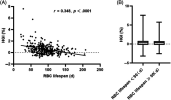Eddy Edson
Well-Known Member
- Relationship to Diabetes
- In remission from Type 2
The 27 is a puzzle. I bet 20c it was a lab glitch. Failing that, maybe something to do with being in the middle of change in RBC numbers due to smoking cessation? weight loss? and average RBC age out of whack compared to steady state.That's impressive progress, but I'm curious about the 27, which looks a bit out of place.
I'm also wondering why, with a hba1c of 83, my fasting glucose was in the high 6s upon diagnosis.
The 27 is a puzzle. I bet 20c it was a lab glitch. Failing that, maybe something to do with being in the middle of change in RBC numbers due to smoking cessation? weight loss? and average RBC age out of whack compared to steady state.
Fasting glucose: that sounds a bit odd??
But HbA1c and LDL-C ticking up. To the extent this means anything, maybe because of lots of stress & lack of sleep over the last few months, or maybe it's because I'm getting really frikkn old & this is the start of my body, like the world, going to hell in a handbasket 🙂
My weight bounces around between 64 and 65 as it has for years. The difference in the avg over the two periods would have been way too small to cause any noticeable metabolic differences.Well maybe. My guess is A1c up from 35 to 37 and weight up from 64 to 65 are related.
I took my eye of the ball June 23 - July 24 and look what happened.
View attachment 32277
I hadn't seen this view of my energy consumption until yesterday. It explained why my A1c went up from 32 to 39 while my weight increased by 3-4 kg after my weight loss diet.
View attachment 32278
Aging, the gift that never stops giving.View attachment 32272
But HbA1c and LDL-C ticking up. To the extent this means anything, maybe because of lots of stress & lack of sleep over the last few months, or maybe it's because I'm getting really frikkn old & this is the start of my body, like the world, going to hell in a handbasket 🙂
My weight bounces around between 64 and 65 as it has for years. The difference in the avg over the two periods would have been way too small to cause any noticeable metabolic differences.
I'm about 10kg below my "personal fat threshhold", assuming that it hasn't changed over the last 6 years.
Is hba1c totally accurate? Could different tests on the same sample on different days might give slightly different?
The machines used in the labs are not entirely accurate. This article from 2015 from Germany illustrates some of the problems - LinkIs hba1c totally accurate? Could different tests on the same sample on different days might give slightly different?
That very last sentence is the nub of it @Eddy Edson - very squidgy indeed as @Docb has been telling us all on here for donkeys years now!

This looks like a nice recent study, seeking to quantify some effects of RBC lifespan on HbA1c measures, for well-controlled T2D's. No surprises but nice to see some quantification.
The influence of shorter red blood cell lifespan on the rate of HbA1c target achieved in type 2 diabetes patients with a HbA1c detection value lower than 7% - PMC
Variations in the red blood cell (RBC) lifespan can affect glycosylated hemoglobin (HbA1c) test values, but there is still a lack of evidence regarding how and to what degree the RBC lifespan influences HbA1c in the type 2 diabetes mellitus (T2DM) ...pmc.ncbi.nlm.nih.gov
As you'd expect, where RBC average lifespan is relatively short, measured HbA1c underestimates average BG (expressed here as "estimated HbA1c", the estimate of HbA1c from actual BG meaurements using the standard best-fit formula derived from the early studies).
It doesn't look at the dual case, where average RBC lifespan is relatively long, but no doubt measured HbA1c will overestimate avg BG in that case.
EDIT:
Figure A below is a good summary:
View attachment 32308
HGI is the difference between HbA1c estimated from BG measurements and measured HbA1c (with HbA1c expressed in US style % units).
